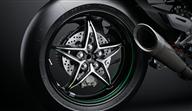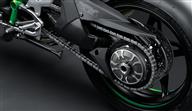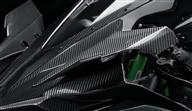Ninja H2R:
Price: Starting at Rs. 79,90,000 (Ex showroom)About Engine and Transmission:
Engine Type: Liquid-cooled, 4-stroke In-line with Super charger
Displacement: 998cc
Max Power: 310PS at 14000 rpm
Max Power With
Power Ram AIR: 326 PS at 14000 rpm
Max Torque: 165 Nm at 125000 rpm
Compression Ratio: 8:3:1
Bore and Stroke: 76mm* 55mm
Valve System: DOHC (Dual overhead camshaft)16 valves
Fuel system: Fuel injection: 50mm* 4 with Dual injection
Fuel Type: Unleaded petrol/RON95
Ignition: Digital
Starting type: Digital
Lubrication: Forced lubrication, wet sump with oil cooler
Transmission: 6 speed, Return
Dimensions and Chassis:
Frame Type: Trellis, high-tensile steel with Swingarm Mounting Plate
Rake/Trail: 25.1 Degree / 108mm
Tyre-Front: 120/600 R17
Tyre-Rear: 190/650 R17
Wheelbase: 1450 mm
Ground clearance: 130mm
Seat Height: 830 mm
Curb mass: 216 kg
Fuel tank capacity: 17 ltr
Overall Dimensions (LxWxH): 2070*1160mm
Brakes and Suspension:
Front/Wheel Travel: 43mm Inverted fork with rebounded and compression damping, spring preload adjustability and top-out springs / 120mm
Rear/ Wheel Travel: New Uni-Trak, Ohlins TTX36 gas-charged shock with piggyback reservoir, compression and rebound damping, spring/ 135 mm
Front-Brake: Dual semi-floating 330mm Brembo Discs
Front-Caliper: Dual Radial-Mount, Brembo M50 Monobloc Opposed 4-Piston
Rear-Brake: Single 250mm Disc.
Rear-Caliper: Brembo, Opposed 2-Piston
Top Features of Ninja H2R:
Brembo Breaks:
A Pair of massive 330mm Brembo semi-
floating with a thickness of t5.5mm deliver
superb braking force.
Riding Position and Ergonomics:
The riding position was designed for riding at ultra-
high speed and circuit riding. To help support the
rider during intense acceleration, hip support pads
flank the rear of the seat. The hip support is
adjustable 15 mm backward to suit rider size.
Electronic Throttle Valves:
Kawasaki’s fully electronic throttle actuation
system enables the ECU to control the volume of
both the fuel (via fuel injectors) and the air (via
throttle valves) delivered to the engine. Ideal fuel
injection and throttle valve position results in
smooth, natural engine response and the ideal
engine output. The system also makes a
significant contribution to reduced emissions.
Ohlins TTX36 Rear Suspension:
The addition of Ohlins’ highly acclaimed TTXshock offers numerous rider benefits:
- Increased rear stability
- excellent damping and increased riding comfort
- Increased rear stability
- Superb feedback from the road
- More stability at speed.
Exhaust System:
All-titanium exhaust system has a very simple
Trellis Frame:
elegant, lightweight solution to meeting the
performance requirements for the chassis.
Bosch IMU:
The use of Bosch’s compact IMU allows an additional layer of precision to be added to the already high-level KTRC, KLCM and KIBS.IMU enables inertia along 6 DOF (degrees of freedom) to be monitored. Acceleration along longitudinal, transverse and vertical axes, plus roll rate and pitch rate are measured.
Cylinder Head:
cylinder head design to ensure the cooling
performance needed for the supercharged
engine. The large coolant passageways result in
the ideal cooling for the combustion chamber.
Ram Air Intake:
Air supplied to the supercharger enters via
dual Ram Air intakes in the upper cowl. Their
total frontal area is approximately 13,000 mm2
—illustrating just how much air is needed to
achieve the over 300 PS output.
Ohlins Electronic Steering Damper:
Kawasaki’s electronic steering damper wasjointly developed with Ohlins, one of the most
popular and respected manufacturers of
steering dampers.
Bank Angle Display:
New instrument features include bank angledisplay and max bank angle recording function
(Possible thanks to the addition of the Inertial
Measurement Unit)
Singal-Sided Swingarm:
Having a single-sided swingarm allows the
exhaust silencer to be mounted closer to the
bike centerline, ensuring a high bank angle
for sporty cornering.
Oil Jets:
In the interest of keeping the engine compact and
simple, a single lubrication system provides cooling
oil for the engine components, supercharger and
transmission.
Kawasaki Original Silver-mirror Paint:
Kawasaki’s new Highly Durable paint features a special coat that allows scratches to repair themselves, enabling the paint to maintain its high-quality finish†. * Soft and hard segments in the coat work together like a chemical spring, creating a trampoline effect that absorbs impacts. † Notes: 1. In some cases, it takes about one week for recovery. 2. The paint will not recover in the case of scratches caused by a coin or key, or zip fasteners.Aerodynamically designed Bodywork:
It is no accident that when viewed from theside, the Ninja H2R does not seem to have the
aggressive forward-canted stance of most
modern super sport models
Dog-ring Transmission:
To facilitate smooth, quick shifting, a dog-ring
type transmission was selected. This is the
kind of transmission commonly found in
MotoGP or Formula 1, and was developed
with feedback from the Kawasaki Racing
Team.
Downforce Generation:
In place of mirrors, the Ninja H2R features
CFRP wings mounted on the upper cowl.
KQS (Kawasaki Quick Shifter):
The Ninja H2R was the first Kawasaki
motorcycle to be fit standard with a quick shifter.
For 2017, the quick shifter also enables
clutch less downshifts.
In-house-designed Supercharger:
The supercharger used in the Ninja H2R was
designed by Kawasaki motorcycle engine
designers with assistance from other
companies within the KHI Group, namely the
Gas Turbine & Machinery Company,
Aerospace Company, and Corporate
Technology Division.
KCMF (Kawasaki Cornering Management Function):
- KTRC (including traction, wheelie and sliding control)
- KLCM
- KIBS (including pitching and corner braking
control)
- Kawasaki Engine Brake Control
Power Unit Designed to Withstand 300 PS Output:
Despite its familiar In-Line Four configuration,
the Ninja H2R power unit is loaded with
technology developed specifically for this
supercharged engine: some new, others with
know-how from the Kawasaki Group.
Kawasaki River Mark:
River Mark on the Ninja H2R. Usually, its use
on a product is reserved for models of
historical significance.
























0 Comments